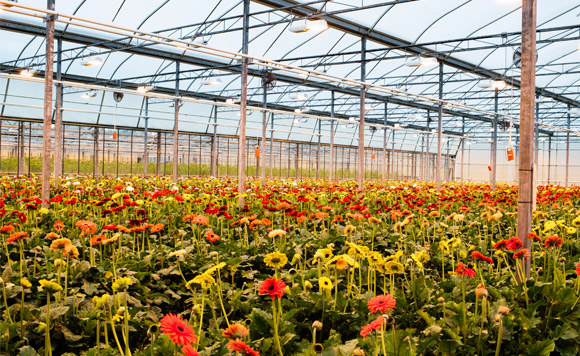by Cassidy Nunn –
If you recently bought or were the lucky recipient of a beautiful bouquet of roses, gerbera daisies or alstroemeria, those flowers most likely began their life at Eurosa Farms here on the Saanich Peninsula.
Three generations of the Bulk family have dedicated their lives to the greenhouses and the flowers that thrive in them. I met with Paul Bulk, Head Grower at Eurosa, to see what goes on behind the scenes to ensure those gorgeous flowers make their way across the province and into bouquets of all sorts.
Paul’s parents began by growing roses on the first five acres of Eurosa Farms in 1979. Things went well until the infamous blizzard of ’96 stormed in and flattened all of the greenhouses. Lots of hard work went into rebuilding the following year and in 2000, another five acres was purchased for more production land. In total, the 10 acres now produce three varieties of flowers: roses (cut and spray varieties), alstroemeria and gerbera daisies. They also grew bell peppers for a few years, but as the demand for roses continued to increase, those greenhouses were converted to roses.
Roses, the farm’s primary crop, begin as cuttings and they’re grown in soil-less coconut husks. A single rose plant optimally lasts for five years and in any given year, approximately 20% of the plants will need to be replaced. In total, roses make up 2.7 acres of Eurosa with almost an entire acre dedicated to spray roses, the tiny little roses with several to a stem that can come in a variety of colours. For optimal growing, the rose plants are lit for 16 hours a day, which is why if you drive by on West Saanich road in the evenings, especially in winter, you can see the greenhouses glowing with a soft orangey light. Most of the growing conditions for all the plants are computer controlled, including lighting, heating and irrigation. The finished roses are harvested every day except Sundays and are prepared to head off to the United Flower Growers auction, which is held in Burnaby three times a week. From there, the roses will head as far as Winnipeg and Portland, Oregon, as well as across B.C. and Alberta.
As with most farming, pests, mainly thrips, which target the head of the rose, are a constant issue. Paul has tested out all manner of techniques for keeping the harmful insects from destroying the plants, including releasing bags of other insects that will leave the plants alone but feed on the pesky thrips, as well as trying to trap them on the yellow cards that provide an extra splash of colour in each row of rose plants.
Thankfully, pests are less of a problem for one of the other flower varities grown at Eurosa: alstroemeria. These plants are grown in soil and like their roots to be kept cool, which is done by tubes of water that run underneath each of the rows. Eurosa Farms was the first farm on the west coast of Canada to grow this variety that boasts a good vase life, a growing life of five-plus years and a lower price point than roses. They come in a variety of colours such as pink, purple, red, white and salmon and have no fragrance.
The third and final variety grown under the bright lights are gerbera daisies and gerbera minis, which hail from South America. “We get to harvest them at the most well-developed stage,” says Paul, while pointing out the difference between a flower that, to my untrained eye looks ready to pick, and another that is fully formed and ready for harvest. Theses plants have a shorter life span of just two to three years and rather than cutting the flowers, they are instead broken off the plant by hand.
If you’ve seen blue roses and wondered “how on earth is that possible?!” you’re not alone. These are dyed roses and Eurosa Farms produces this “variety.” They begin as a cream rose and after being cut, they are immediately processed in the cooler where they sit in the dye for 24 hours; as they drink up the dye, the cream rose will soon change colour. They have the same vase life as regular roses.
Eurosa employs about 30 staff members throughout a variety of departments. From picking to bouquet making to office administration, it’s a busy team that keeps this farm running smoothly. You too can meet the team and have a behind the scenes look at Eurosa Farms on Saturday, June 15 from 11 a.m. to 4 p.m.! There will be guided tours, floral displays, a silent auction and door prizes, all in support of the SUPA Society.
Photo by Nunn Other Photography.




